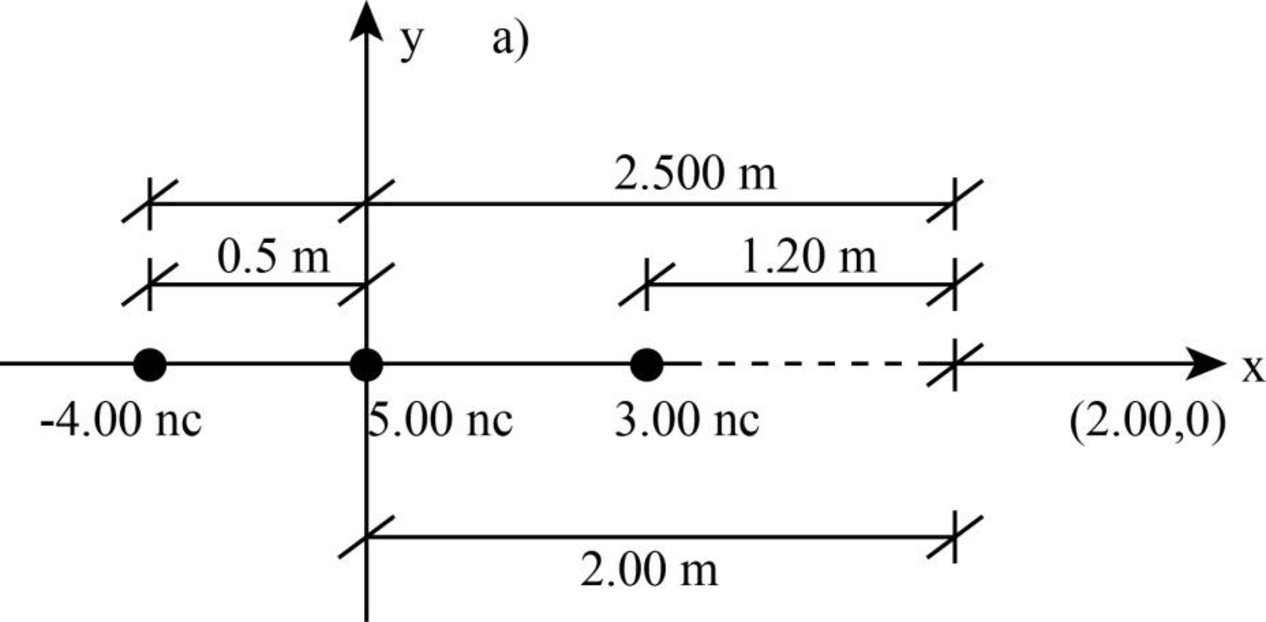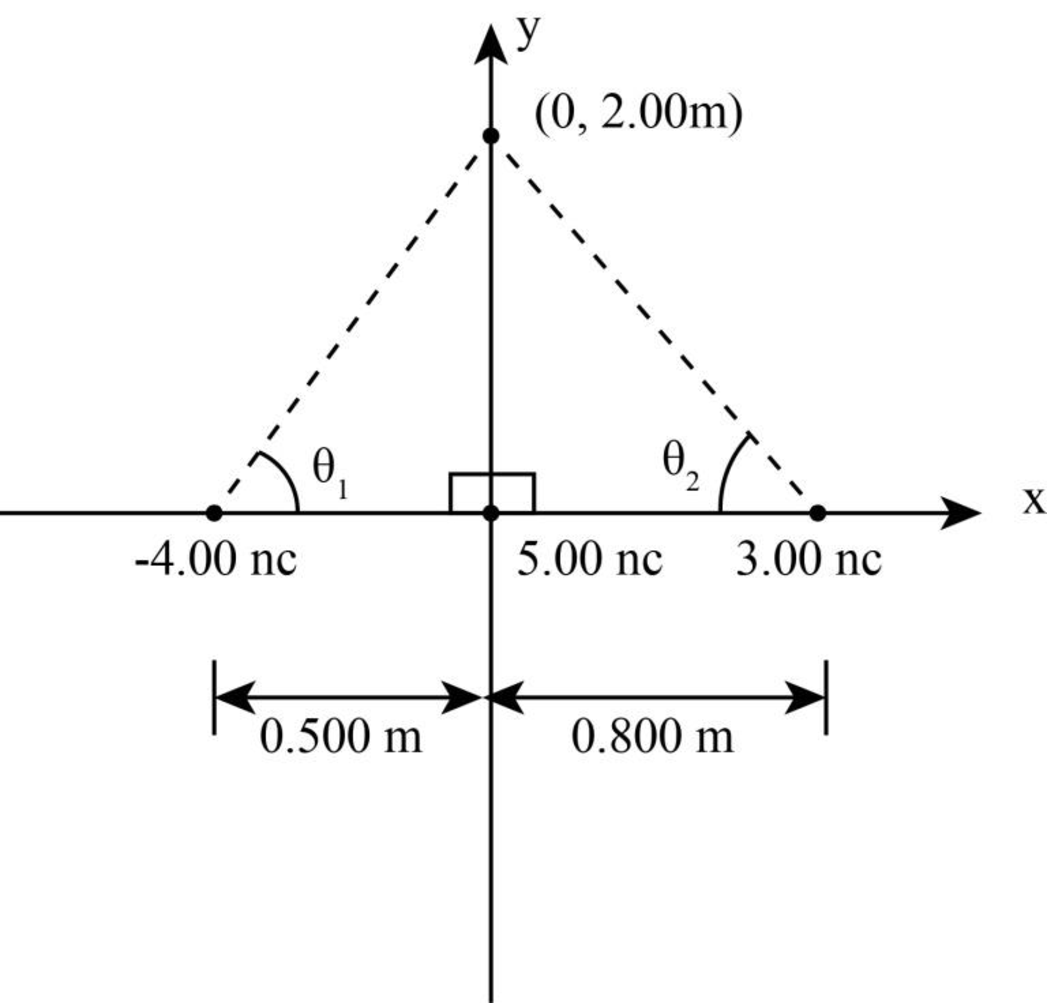
Concept explainers
(a)
The electric charge at
(a)
Answer to Problem 69AP
The electric field at
Explanation of Solution
Conclusion:
Write the expression for the electric field.
Here, s is the total electric field,
Write the expression for the electric field.
Here,
Substitute
The following diagram shows the distance of the charges from

Figure-(1)
Substitute
Therefore, the electric field at
(b)
The electric field at
(b)
Answer to Problem 69AP
The resultant electric field is
Explanation of Solution
Rewrite the equation (III) for resolving the forces along
Rewrite the equation (III) for resolving the forces along
Write the expression to calculate the electric field at
Write the expression for the resultant electric field.
Here,
Write the expression to calculate the direction.
Here,
Conclusion:
The following diagram shows the distance of the charges from

Figure-(2)
From the figure-(2) calculate the distance of the charge from the position
Consider the triangle
Consider the triangle
Consider the triangle
Consider the triangle
Substitute
Substitute
Substitute
Then the resultant force is,
Substitute for
Substitute for
Direction of the resultant force is,
Therefore, resultant electric field is
Want to see more full solutions like this?
Chapter 23 Solutions
PHYSICS:F/SCI...W/MOD..-UPD(LL)W/ACCES
- In Figure P24.49, a charged particle of mass m = 4.00 g and charge q = 0.250 C is suspended in static equilibrium at the end of an insulating thread that hangs from a very long, charged, thin rod. The thread is 12.0 cm long and makes an angle of 35.0 with the vertical. Determine the linear charge density of the rod. FIGURE P24.49arrow_forwardA Figure P23.65 shows two identical conducting spheres, each with charge q, suspended from light strings of length L. If the equilibrium angle the strings make with the vertical is , what is the mass m of the spheres? Figure P23.65arrow_forwardaA plastic rod of length = 24.0 cm is uniformly charged with a total charge of +12.0 C. The rod is formed into a semicircle with its center at the origin of the xy plane (Fig. P24.34). What are the magnitude and direction of the electric field at the origin? Figure P24.34arrow_forward
- A uniformly charged insulating rod of length 14.0 cm is bent into the shape of a semicircle as shown in Figure P23.45. The rod has a total charge of 7.50 C. Find (a) the magnitude and (b) the direction of the electric field at O, the center of the semicircle.arrow_forwardFind an expression for the magnitude of the electric field at point A mid-way between the two rings of radius R shown in Figure P24.30. The ring on the left has a uniform charge q1 and the ring on the right has a uniform charge q2. The rings are separated by distance d. Assume the positive x axis points to the right, through the center of the rings. FIGURE P24.30 Problems 30 and 31.arrow_forwardWhy is the following situation impossible? A solid copper sphere of radius 15.0 cm is in electrostatic equilibrium and carries a charge of 40.0 nC. Figure P24.30 shows the magnitude of the electric field as a function of radial position r measured from the center of the sphere. Figure P24.30arrow_forward
- A uniformly charged rod of length L and total charge Q lies along the x axis as shown in Figure P23.6. (a) Find the components of the electric field at the point P on the y axis a distance d from the origin. (b) What are the approximate values of the field components when d L? Explain why you would expect these results. Figure P23.6arrow_forwardA particle with charge Q = 5.00 C is located at the center of a cube of edge L = 0.100 m. In addition, six other identical charged particles having q = 1.00 C are positioned symmetrically around Q as shown in Figure P23.19. Determine the electric flux through one face of the cube. Figure P23.19 Problems 19 and 20.arrow_forwardEight small conducting spheres with identical charge q = 2.00 C are placed at the corners of a cube of side d = 0.500 m (Fig. P23.75). What is the total force on the sphere at the origin (sphere A) due to the other seven spheres? Figure P23.75arrow_forward
- Three identical charges (q = 5.0 C.) lie along a circle of radius 2.0 m at angles of 30, 150, and 270, as shown in Figure P15.33 (page 524). What is the resultant electric field at the center of the circle? Figure P15.33arrow_forwardA circular ring of charge with radius b has total charge q uniformly distributed around it. What is the magnitude of the electric field at the center of the ring? (a) 0 (b) keq/b2 (c) keq2/b2 (d) keq2/b (e) none of those answersarrow_forwardThree identical charges (q = 5.0 C.) lie along a circle of radius 2.0 m at angles of 30, 150, and 270, as shown in Figure P15.33 (page 524). What is the resultant electric field at the center of the circle? Figure P15.33arrow_forward
 Physics for Scientists and Engineers: Foundations...PhysicsISBN:9781133939146Author:Katz, Debora M.Publisher:Cengage Learning
Physics for Scientists and Engineers: Foundations...PhysicsISBN:9781133939146Author:Katz, Debora M.Publisher:Cengage Learning College PhysicsPhysicsISBN:9781305952300Author:Raymond A. Serway, Chris VuillePublisher:Cengage Learning
College PhysicsPhysicsISBN:9781305952300Author:Raymond A. Serway, Chris VuillePublisher:Cengage Learning College PhysicsPhysicsISBN:9781285737027Author:Raymond A. Serway, Chris VuillePublisher:Cengage Learning
College PhysicsPhysicsISBN:9781285737027Author:Raymond A. Serway, Chris VuillePublisher:Cengage Learning Physics for Scientists and Engineers with Modern ...PhysicsISBN:9781337553292Author:Raymond A. Serway, John W. JewettPublisher:Cengage Learning
Physics for Scientists and Engineers with Modern ...PhysicsISBN:9781337553292Author:Raymond A. Serway, John W. JewettPublisher:Cengage Learning Physics for Scientists and EngineersPhysicsISBN:9781337553278Author:Raymond A. Serway, John W. JewettPublisher:Cengage Learning
Physics for Scientists and EngineersPhysicsISBN:9781337553278Author:Raymond A. Serway, John W. JewettPublisher:Cengage Learning Physics for Scientists and Engineers, Technology ...PhysicsISBN:9781305116399Author:Raymond A. Serway, John W. JewettPublisher:Cengage Learning
Physics for Scientists and Engineers, Technology ...PhysicsISBN:9781305116399Author:Raymond A. Serway, John W. JewettPublisher:Cengage Learning





